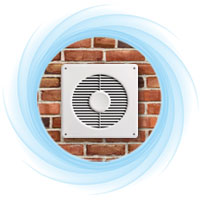Subfloor Ventilation
A damp sub-floor can be the perfect area for mould growth which can cause stale and musty odours to permeate into living areas.
Damp in the sub-floor can also lead to rot and provide an environment that encourages termite activity, threatening the structure of your home. EcoFAN’s high flow rate exhausts damp air from your subfloor helping to protect your family and your home.
ecoFAN
Under floor powered ventilator with interchangeable exhaust or inward air flow capability, mounted into the exterior wall under the ground floor level of the home.
If you are thinking about installing subfloor ventilation, review the information below to find out what subfloor ventilation is, how it works, why you need it, its benefits, and the different options available.
What is subfloor ventilation?
Subfloor ventilation is the extraction of damp air from your home's subfloor, which is then replaced with fresh dry air. This is achieved by installing a series of air vents in the exterior subfloor of your house.
How does subfloor ventilation work?
Subfloor ventilation replaces moist air with fresh, dryer air. It does this by using strategically placed sub floor fans that speed up the natural drying process by drawing fresh air from one side of the structure to the other through the underfloor area. As it does so, moisture is extracted via the other side of the underfloor area.
Why do subfloors need ventilation?
When the soiled areas a house is built on become affected by moisture outside, it has a negative effect on the subfloor space. A comprehensive subfloor ventilation system dries out the subfloor space by removing the damp air trapped in the subfloor that can cause mould growth and structural damage due to condensation. Poor quality air in an underfloor area can also flow into living areas, creating breathing problems, especially for those suffering from asthma and allergies.
What are the benefits?
- Reduces moisture and mould build-up.
- Reduces condensation build-up on timber supporting structures.
- Discourages termite and pest infestation.
- Helps reduce the likelihood of allergies and respiratory problems.
- Reduces odour from a constant flow of fresh air.
What are the different subfloor ventilation types?
There are two main types of subfloor ventilation, and most houses usually have them working in tandem. They are powered vents and static vents.
Powered vents: These mains-powered extractors and inflow vented fans provide powerful and effective ventilation at any time of the day or night, with variable and fixed-speed controls to suit your location and needs and further improve energy efficiency.
Our powered vent option is the Bradford EcoFan. The EcoFan offers:
- Condensation management: made possible by three preset speeds for continuous and reliable reduction of condensation.
- Humidity detection: automatically adjusts its speed setting based on the levels of humidity detected.
- Healthier homes: replacing stale air with fresh dry air reducing household allergens and respiratory issues.
Static vents: These allow for natural airflow to pass through and ventilate a home’s subfloor spaces without the need for electrical power.
Contact Bradford's subfloor ventilation experts to discuss your home's current ventilation issues and to learn how our products can help address them. You can reach the Bradford Ventilation team by calling 1300 858 674 or filling out an enquiry form.


